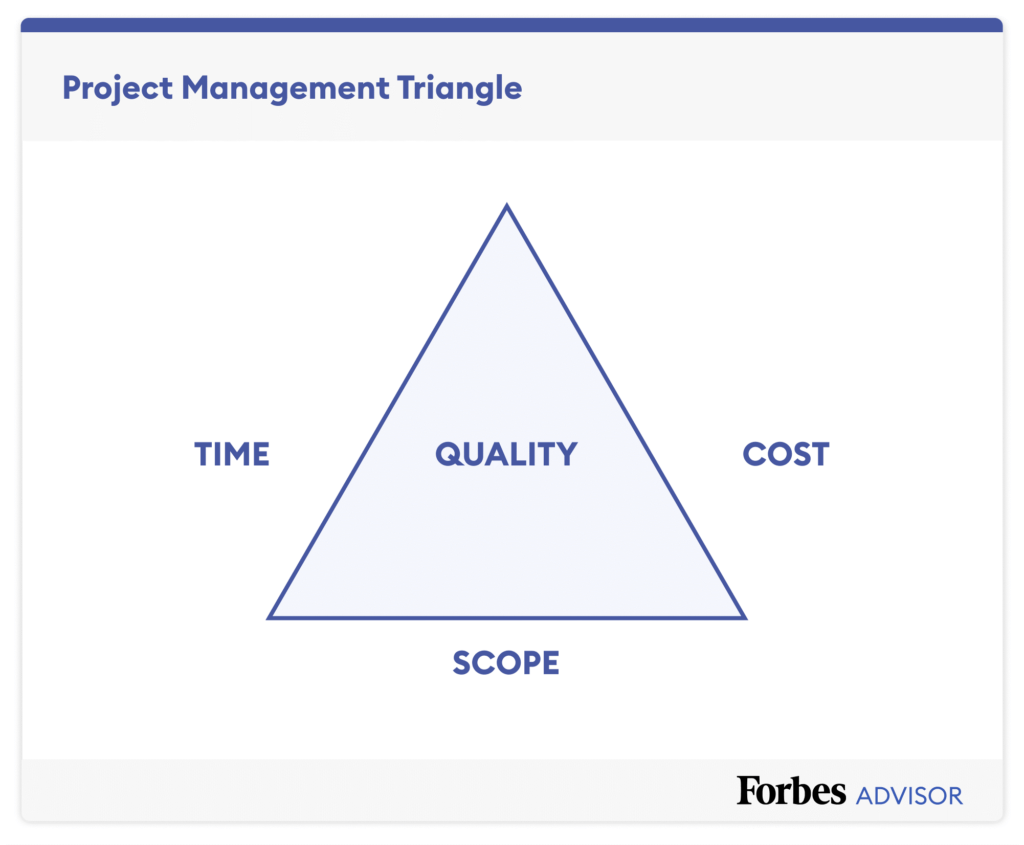Welcome to our exploration of the Project Management Triangle, often referred to as the Iron Triangle of Project Management. In the world of project management, balancing time, cost, and quality is the key to success. This triangular framework serves as a compass, guiding project managers through the complexities of their endeavors.
Decoding the PM Triangle
The Project Management Triangle, also known as the Iron Triangle or Triple Constraint, is a model emphasising the constraints of scope, time, and cost that apply to any project. Understanding these three elements is critical for project success. Scope refers to the project’s size, goals, and requirements. Time is the schedule for the project’s completion, and cost represents the budgetary limitations. Balancing these factors is essential; emphasising one can often lead to compromises in the others. For example, extending a project’s scope may require additional time and increase costs, whereas reducing costs may impact the scope or extend the timeline.
In the context of team dynamics, the PM Triangle serves as a visual aid and decision-making tool. It helps team members grasp the interplay between their project’s primary constraints and guides them in making informed trade-offs. When the triangle is balanced, it indicates a well-managed project. Thus, it is not only a measure of project health but also a strategic asset in planning and executing projects.
 Balancing Time, Cost, and Scope
Balancing Time, Cost, and Scope
Project managers often face the challenge of delivering projects within a limited budget and timeframe, without compromising on the quality or breadth of work. To achieve this balance, they must be adept at planning, resource allocation, and stakeholder communication. Prioritising tasks, setting realistic milestones, and continuously monitoring progress against the plan are key practices that help maintain this balance.
It’s also imperative for project managers to manage expectations by communicating the implications of changes in one area on the others. For example, if a client requests additional features (scope), the project manager must convey the necessary adjustments to the budget (cost) and schedule (time) to accommodate these changes.
Strategies for Navigating Constraints
Project Management Triangle
Effective strategies are vital for navigating the constraints within the Project Management Triangle. Risk management is one such strategy, involving the identification, analysis, and mitigation of potential obstacles that could affect the project’s constraints.
Starting with a clear plan that is presented to the client that clearly details the scope of the project. Within this plan, identify potential triggers that could cause the project to go wrong, and what can be done early to address them. These plans need to detail how the budget, scope, and schedule would be adjusted in the event that such risks come up.
A continues process of proactive communication between the team and client will help keep projects on track especially when dealing with problems. Where possible, the ability to solve a problem early by implementing the risk management plan can help prevent the time of the project being effected.
Another strategy is to employ a change management process to assess and respond to any changes in project scope, time, or cost in a controlled and systematic manner. As a project manager, you can be as prepared as possible, however, if change arises (which it normally does), the scope, time or budget could go awry, throwing the balance of the PM triangle out.
Forbes identifies several components to address change:
- Revision of Change Management Roles:
– Identification of authorised personnel for receiving and evaluating change requests for approval or rejection.
– Determination of stakeholders involved in the execution of approved change requests.
– Specification of team members responsible for adjusting project constraints—scope, time, and cost—to accommodate approved changes. - Setting Limitations:
– Documentation of constraints deemed non-negotiable when adapting to change.
– Identification of constraints open to flexible adjustments to accommodate change requirements. - Process for Change Request Approval or Rejection:
– Establishment of procedures for submitting, evaluating, and deciding on change requests (approval or rejection). - Time Frame Parameters for Change Requests:
– Defining time frames for the assessment, approval, rejection, and implementation of change requests.
– Establishment of deadlines beyond which change requests will not be considered.
Moreover, project managers can use prioritisation techniques to focus on high-value tasks and make trade-offs between the constraints as necessary. Regularly revisiting and revising project plans to reflect the current reality of the project can help prevent scope creep, timeline slippage, and budget overruns.
Adapting the Project Management Triangle
Agile Environments
In agile environments, the Project Management Triangle still applies, but it is adapted to fit the iterative and flexible nature of Agile methodologies. Instead of a fixed scope, Agile projects often have a variable scope that allows for changes based on stakeholder feedback and project insights. This flexibility means that time and cost are often the more fixed constraints, while quality is integrated into the scope through continuous improvement.
Agile project managers use tools like backlogs and sprints to manage time and cost effectively while allowing for scope adaptation. They embrace change as a part of the process, ensuring that the project delivers value and meets the evolving needs of stakeholders. By focusing on delivering small, incremental pieces of the project, they can better manage the constraints of the Project Management Triangle and drive project success.
Conclusion
In navigating the complexities of project management, understanding and effectively managing the constraints within the Project Management Triangle are crucial for success. By prioritising scope, time, and cost, project managers can maintain balance and drive projects toward their objectives. Strategies such as risk management, proactive communication, and change management help mitigate potential challenges and keep projects on track.









